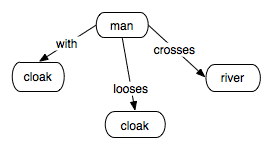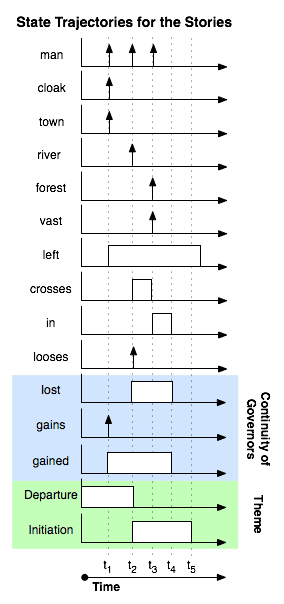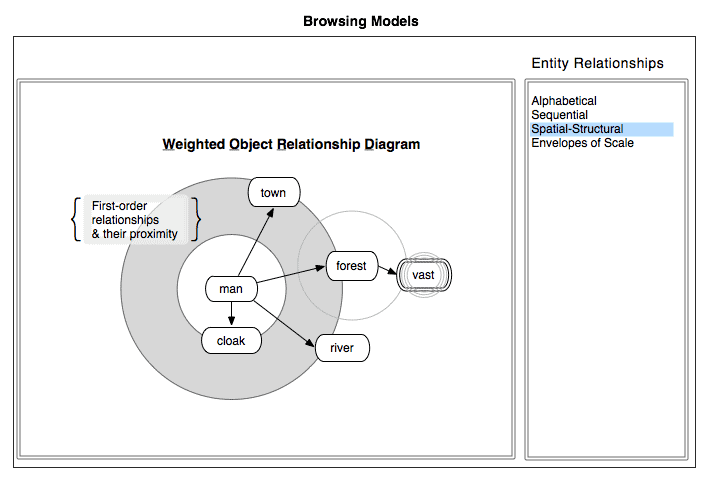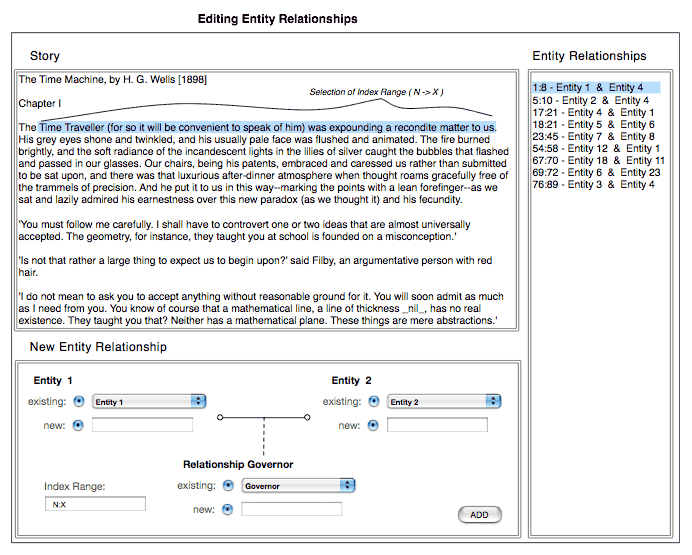Bardcruft
New Alexandria
S06: AME; Media Theory. Aisling Kelliher
"Give me your wired, your poor
your muddled languages, yearning to converge
the wretched refuse of your memes and lores.
Send these, the homeless, ages-tossed to me
I lift my voice unto a silent roar"
|
Caveat
In reaching for the design of a macroscope 1, I've had to consider the method of its rendering. Given the ubiquitous breadth of material that it suggests via association, a root domain of consciousness was necessary to begin rendering.
I identify that this design method allows for the system itself to attend more and less to certain forms, as its functionally emerges from that initial domain. Even with a thoroughly transparent and tightly-knit mechanism for self-referentiation, the likelihood of a meaningful bias is high. Correcting for that bias requires a relational superset.
Thus I propose that were the process of developing a macroscope system to be rooted in different domains of origination the result would be a set of macroscope-tools. Each would compose perspectives on the world that were formulated from the unique, though dependently co-arising 21, cultural grammer of each.
|
Introduction
That said, the initial cultural form I propose to develop for is mythology. 'Mythology,' I identify as any story, legend, tale - be it written, spoken, danced, depicted or otherwise expressed. Though these categorizations of communication themselves are broad, they are limited to those expressions which are story.
'Story,' is any account, regardless of the way, or whether, truth is associated with it. These accounts I proposed to be the registers of consciousness. Experientially, they are stations, upon the timing of whose relationships grammar emerges. The level of grammar thus conveyed can result is language, though it is only one element in a set of origination.
As a result, story itself can morphologically similar across other macroscopic cultural forms, such as language. Joseph Campbell conveyed this in his Hero of 1000 Faces.22 Part of initiating vision of the 'mythology macroscope' system is the mapping of stories so as to reveal their symmetry - i.e the dimensions of similarity and dissimilarity. Symmetry so formalized yields information about the structure of consciousness that is non-corporeal, yet indivisible.
Campbells work exemplifies the colloquial statement that Tolkien's literary work The Lord of the Rings23 is the "second best-selling, second most-translated, book on Earth" (the first being the Bible). It is an assertion that both stories draw from broad cultural foundations, and are both very symmetrical with the grammars of human consciousness. Mapping the morphology of stories is thus revealing of structural symmetries in consciousness. Beyond the non-discrete value of understanding general consciousness better, the tool would provide a way to better understand existing stories and aid in the identification of new narrative terrains.
|
Historical Associations
Stories are morphological to the surrounding environment / phenomena. Hamlet's Mill paints a picture of a world where story is composed from the structuralism of one's environment.26 The emergence of story from the environment is present in the oldest cultures development of knowledge. I consider this to be apriori to vernacular developments
A ready example exists with the Aztec people 27, where the concept of 'body' is something informed both by the human form as well as environmental morphology. Thus both human and environment are understood to be something more than their physically morphological representations - their component elements are composed of relationships informed by all that is environmentally associated. Morphologically-distinct entities become composures of relationships that themselves are in relationship to other forms. From this foundation, story within the culture then emerges. The story therefore closely derives from the relationships stated and explicit.
As well, story can bear direct morphological connection to its environment. Kearney gives a wonderful example of this: "The classic example, cited by Levi-Strauss, is of the woman who has difficulties giving birth: suffering from a blocked womb, she is told the 'myth' of the good warriors freeing a prisoner trapped in a cave by monsters, and on hearing the plot resolution recited by the shaman, she gives birth to her child."28 As much as the woman birthing connects herself to the structure of the story, we can assume safely that the biological act of a difficult birth precedes the story. Certainly the concept that they have a co-emergent origination is as compelling as the suggestion that the telling of the story can effect the events of the environment. In fact, the system is in part conceived around the possibility that light could be drawn to the association of story elements to subtle environmental details.
In designing a system for bringing light to potential associations within stories, the focus is upon generalisms - thus I chose not to attempt a comprehensive definition of 'story.' The comprehensive definition of any superset always has the potential to be greater than the parent it inherits from. The system sketched here is purposed for people to record stories as a function of their elementary relationships - towards the aim of a system for exploring general forms of relationships. Thus, it is the understanding and exploration of relationship itself that is the aims of the system.
I have thus far found no other systems for the modeling of story in which relationship is the focus. I propose many of the elements of narrative, story and presentation to be social conventions used to mimic the mind and/or body of a storyteller. Dramatica Theory's "throughlines" 24 are an excellent rendering of such. OpenMind's collection of facts is even higher-level, looking not only at abstract concepts - but as well limiting itself to those that are "reality-based."
The Aristotelean form is essentially one of constructing the form of relationships that most pleases - be it within the telling of a story or in the rendering of one's own life. Aristotelean catharsis is, in my focus upon root relationships, less an aspect of story itself and more a matter of human response to a story. Ethos has a similar connection; it arises more from human response to the story, rather than being an inherent aspect of the story itself. Mimesis would them be the process by which we arrive at responses - cathartic and otherwise. Phronesis and Mythos, however, I'm am inclined to identify as being more-or-less identical in their connection to the relationships of a given story. Their message is their medium.
The fixation upon narrative displayed by the general learned community belays an obsession with time, and specifically with mortality..... "where are we going." The cultural presentation of many indigenous stories are not ingrained with this quality of time - and the cultural difference has escaped and confounded many Western scholars. 10 I will even go so far as to suggest that the concept of narrative is a distinctly Western creation, emerging from ever-moving, ever-traveling peoples. Its focus upon a linear evolution of the individual can be seen as rooted in the necessity to marker consistency when constancy of place is not available. This concept is reinforced by the often familiar, often ready escape-based story opening: "in a land far away" / "a long time ago" (i.e. when the locale was unrecognizably different).
Place-focused and time-focused stories are not irreconcilable, however. In line with my general theme, I offer that it is the relationship between entities that is the commonality to the experiences from which stories arise.
My intention is not to become too enshrouded in the architecture of presentation - but rather to keep simple to the underlying framework of a story: the relationship between its elements, and the change of those relationships over time. Ultimately, I look toward a definition of a story's elements to be clusters of relationships. If a story element can be defined as a cluster of relationships, then the whole of a story can be recursively defined, and fractal in structure.
The system for elucidating these relationships comes into its own through the same form of 'participatory culture' that gave rise to story in the first. All people, upon hearing a story of any caliber, associate with the tale to various degrees, and by this formulate the story's relationships to their own nature. By labeling relationships by their own sensibilities the sum total of user interaction begins to paint a general picture of the cultural mind (or demographics thereof). This consensus approach is similar to the common-sense mechanisms implemented in public projects (ConceptNet, LCS, OpenCyc, OMCS, WordNet, etc.), but would instead apply those mechanisms to a different base of elements.
|
System Considerations
Elements of morphological mapping would include entities signified though body or symbolized as place, the relationship between entities, relationship governors, and the sequencing of relationships. 'Relationship governors' present themselves through language as prepositions, qualifying a particular order of arrangement.
In essence, these elements are structural, relational, spatial, or temporal. The qualities of an entity are themselves a subset of entity relationships, and inherit the ability for their sequencing to be mapped. Qualities are unique in that they are not required to inherit governing qualities of a relationship. Every entity relationship is associated with a congruence measure that is expressed as a spread 2 of first-order relationships.

Given enumeration, the measure of relational congruence could be expressed as a real number. Implementing through the use of a relational database, congruence may be evaluated via relational calculus 3 inherent to the method. Thus real expression can be limited to necessity, and data that compose these relations has the to opportunity to be mapped in like kind to its composure.
Number of words associated with a given morphological element is an inverse measure of [archetypal] efficiency. The number of words able to be associated to an element determine the half-life of a given piece of information - i.e. its durability over significant societal change. The measure of half-life is essentially one of foundations - the more ways that an element can be expressed the longer it is likely to remain relevant, and present within consciousness.
|
Modeling a Story Element
Let us consider the following narrative; "A man crosses a river, loosing his cloak as he goes." As the core element of a parable it may be complete, though it is capable of being nested within a larger narrative; "A man with a cloak left town to cross the river. In crossing, he looses his cloak. He then goes in the vast forest." With a model of morphological elements, the previous parables can be mapped:

In the absence of temporal characteristics a story could be mapped with greater flexibility and variation.

Though the sequencing of events is critical to certain symmetries, the governor of a relationship will remain regardless of the tense it is cast in. This is not to say that it is tenseless, but rather that once a relationship has been governed in a given manner it is forever an aspect of the morphological development.
We can view the tense in greater detail via the state trajectories of the story elements. A state trajectory plot here depicts the presence of various elements in selected regions of a narrative text.

The trajectory plot illustrates a the tenseless nature of governors, in that once the man has left the town he has forever left it. This 'continuity of governors' is further illustrated in the man's relationship to his cloak. Though he can be considered to loose and gain the cloak only at specific times, by t3 it can be said that he has both lost and gained a cloak. Thus, the choice to use sequencing can lead to different structural characteristics.
Structures of entity relationships existing at any scale of sequencing gives rise to themes, moods and other measures. Campbell uses separation / departure, initiation, and return as archetypal themes. 6 The 31 "narratemes" of Vladimir Propp 7, when divided in 3 groups of naratemes 1-11, 12-19, 20-31, roughly corresponds to Campbell’s structure. These first-order structures, though generalizations of their various component relationships, are atomic in relationship to others of the same order. The state trajectories illustrate the association of first-order structures (i.e. themes) to governors.
Linguistically, these themes gain associations via nouns, in their adjective-to-noun and verb-to-noun relationships. The presence and absence of symmetry between these high-level relationships is what the proposed system is designed to render.
|
Interfacing this Model
The information architecture of the system (in this case, its database structure) is the primary determinant for any interface that could be created. The following database schema provides structure for stories, entities, entity relationships, and supporting tables. Notably absent from a functional system are user tables and versioning. They are left out primarily due to the visual complexity they would add at this level of design.
Entities_Entities holds the structural and relational aspects of a story, while Governors holds the spatial relations. Though Governors and Entities are are structurally identical they seem, at this stage, to represent significantly different concepts as to warrant their own data structures. The EntitySet group of tables is created in anticipation of word clusters. These would include different tenses (gains, gained) and inflections (green, greenness, greenly, greening) and other grammatical associations. In the example of our parable above, the forest is vast - but how do me measure vastness, or how vast the forest is? The system would measure 'vastness' by the aggregated spread of first-order relationships from each instance of vastness, vast, vastly, etc. These provide context in the event that we have a reason to consider just how vast a given forest is!
Ideally, the database could be populated with element data based upon stories that are human-entered or agent-gathered. Even with good algorithms there is some additional work to be performed by hand. The interface will also allow initial setup of story data prior to the development of sufficient algorithms.
Several interface modes would facilite different operations within the system. A browsing mode would cover view of story, entities, relationships - each in their various linear and 2D display formats. An entity relationship edit-mode would facilite structuring of the data. A wiki mode would be close at-hand to the browsing mode, allowing editing of the base story. However, editing of the base story could potentially remove elements for which relationship have already been defined. In this case the edit would enter a queue for community review, or would be disallowed to some user-trust levels. I will touch on user trust later.
Browsing mode would, in itself revolve around the display of system data. The overall design rubric is the lack of its removal. Its overall intention is to be a lens of selective filtration. Due to the virtual nature of the data, the filtration in this case is ordering - filtration as a process of separation.
Obvious ordering / viewing modes would be Alphabetical, Sequential, Spatial-Relational - with others likely to be available. The rubric and intention for graphics is to parallel structuralism in the datum. Thus, the distance of depicted first-order entities is dependant upon the prevalence of relationship. The 'boolean penumbra' of relevance is rendered as a scalar range. The number of second-order relationships via any first-order entity is depicted as the number of external rings around the first order entity. Relationship to third order quality-entities maintain this convention when viewed - though the rings for third-order relationships are spaced internally.
( For the punny mathe-mythologists I'll offer the classically undaunted 'groaner': FOEs, SOEs, TOEs; the First-Order Relationships are those which the entity 'vies' with to define itself, the Second-Order Relationships are those that 'thread' together ( sews ][ soes ) the entity's id-entity, the Third-Order Relationships are those that an entity uses to 'test the waters' of other relationships. )
The resultant object-structure is harmonic to a story's axes of symmetry. Navigation could occur via activation zones nested within the visual formatting. Periodic graphing of the set of all word diagrams is the mythological space of a story. Thematic entity 'word' diagrams should be congruent to domains of partially-symmetric entity relationships. The possibility thus stands to derive or evaluate them.

I envision a split-page display of story, entity creation and existing entity relationships.

10 11
The construction-integration model29 renders operating system views of the code execution, all of which depict data that is known to be problematic to discern for its abstraction of notation.30 Direct dimensional representation of element structure allows certain aspects of story element form to be perceived without additional navigation. The graph renderings of Reeves31, though instrument to early systems understandings, are not integrated with a system for media rendering - particularly difficult with the code given.
Using models presented in the recent "Web 2.0" image cut-up tools and similar usage patterns, image files generated in 'touchpad whiteboard' sessions could be further manipulated, tagged, and associated in mediated social structures (OSS codes1).
|
Implementation Architecture
For a variety of reasons 18 , the Zope3 development framework is felt to be the best approach to system design. Zope3's component design model 19 is structurally similar to the proposed system, and therefore is prime to facilitate development. As well, it has rigorous permission and rule structures that allow an editing-permission gradient. Monitoring changes based on a trust gradient can allow community self-regulation to occur in proportion to the size of the community. Another fortuitous aspect to hack & defacement monitoring is that from the initially open system - hack targets are highlighted in a manner of providing structured dissent; graffiti in is digital form; an emerging channel for cultural expression.
|
Coda
"Bionics 9 is the study of living systems with the intention of applying their principles to the design of engineering systems. So a bionic system would be an “engineering” system that has the principles of living systems. Some examples of bionic systems:" 8
Bardcruft 13 17, and the Rafiki 1 model it is derived from, are not "bionic," as it is not a system designed to provide an automation function. Rather it is intended to operate more as a lens, permitting users access to a wider range of data using their inborn faculty. Such a 'lens' system could utilize a bionic mechanism in order to re-engineer beyond-context scales of phenomena in biological (i.e. familiar) ways. But again the purpose of the system is to facilitate experience transparently. Data is displayed based upon human assumptions, and where the display methods are modified we then have conscious adaptation toward change beyond the scale of the modifying actor - and therefore not purely a "bionic" system.
The 'Dream Loom' 15 system earlier developed is an aesthetic way to view and reconsider a story's entity relationships. Its design is intended toward recombinant viewing of a stories elements within their original structure, as well as allowing derivative relationship structures to emerge. In this way the system may function as a 'mythological isopsephy' 17 - on the order of gematria, and other meaning-cyphers. Similar to gematria and other meaning-cyphers, the integrated dimensions form the ontological space.
Under each of these influences, Bardcruft offers a model of development that evokes the forms of interaction that are indicatively associated to 'participatory culture.' The 'participatory' model is intended to be structurally homologous to indigenous exchange networks, which gave rise to similar social complexity. Ron Eglash is not the first to introduce this concept. However, in his case with Ojibway scrolls33 he presents documentation of indigenous 'participatory' practices in relationship the awareness that they embody, and allow direct perceptual relationship to deep complexity.
The document "Topological Association of Quantum Mechanics and Consciousness" 14 outlines more on the structuralism of perception that gives rise to macroscopic intervals of scale, upon which this system is conceived from.
Within the context of a macroscope-based instrument a essential utility of mythological mapping is a deeper insight into the languages in which stories are crafted. Linguistic systems are known to predispose cognition and perception. Informal assertions include Pauli's presence as the 'language of dharma,' Napolean's summarized 'French is for lovers, German is for giving orders,' and the ubiquitous usage of English language and currency for international barter and exchange of all forms. 'Fictional'4 languages may thus be considered as emergent with the development of new forms in consciousness - providing currency that facilitates growth.
It is estiamted that a macroscopic survey of story symmetry across languages will help illuminate the concepts which a given language has more utility expressing. Beyond this function, it is estiamted that the tool's graphical rendering would also form the basis for founding a semasiographic 20'general systems language.' The image is one of graphical structure that denotes the relationship forms present across diverse systems, such as stories, law, ecology, and others.
|
Closing caveat
A rather comprehensive bibliography has been assembled by Erik Mueller 32 detailing the extensive history on the subject of automated story parsing. The 'bardcruft' work implies a position and further development of concepts in relation to the collected works that may be further articulated.
|
References
- [1] Rafiki: http://newalexandria.org/projects/rafiki/
- [2] Wildeberger, N.J. Divine Proportions. Wild Egg. 2005
- [3] Relational Calculus : http://www.cse.scu.edu/~lseiter/97-98/coen178/ch7.html
- [4] Total language index: http://www.langmaker.com/
- [5] Oxford English Dictionary: http://www.oed.com
- [6] Levi-Strauss, Claude., Myth and Meaning. Schocken Books, New York. 1978
- [7] Propp, Vladimir, Morphology of the Folktale (Morfologiia Skazki), Austin, University of Texas. 1970
- [8] http://www.seedround.com/bionic-systems-amplify-participation
- [9] http://www.encyclopedia.com/html/b/bionics.asp
- [10] JS get text position: http://weblogs.asp.net/skillet/archive/2005/03/24/395838.aspx
- [11] JS text functions: http://www.webreference.com/programming/javascript/gr/column11/2.html
- [12] Cruft: http://en.Wikipedia.com/fancruft
- [13] Bard: http://en.Wikipedia.com/bard
- [14] Topological Association of Quantum Mechanics and Consciousness: http://www.newalexandria.org/papers/macroscope/Topological_Associations.pdf
- [15] Dream Loom: http://newalexandria.org/works/dreamloom/
- [16] Poem: http://www.newalexandria.org
- [17] Isosephy: http://en.wikipedia.org/wiki/Isopsephy
- [18] Rafiki models: http://newalexandria.org/projects/rafiki/OSmodels-cms.html#zope
- [19] Weitershausen, Phillip von. Web Component Development with Zope 3. Springer. 2005
- [20] Writing Systems: http://www.grsampson.net/AWsy.html
- [21] Buddhist dependent co-arising: http://philtar.ucsm.ac.uk/research/jret/5090.html
- [22] Tolkien, J.R.R., Lord of the Rings. Houghton Mifflin, 1974.
- [23] Campbell, Joseph. The Hero with a Thousand Faces. Bollingen, 1972.
- [24] Phillips, Melanie Anne, & Huntley, Chris (1993). Dramatica: A new theory of story. http://www.dramatica.com/theory/theory_book/dtb.html
- [25] Tomlinson, G. "Unlearning the Aztec cantares." Subject and Object in Renaissance Culture. Ed. M. Grazia et. al. Cambridge University Press. 1996
- [26] G. Santillana, H. Dechend. "Hamlet's Mill: An Essay Investigating the Origins of Human Knowledge And It's Transmission Through Myth." David R. Godine Publisher. 1969
- [27] Carrasco, David. "The Tezcatlipoca Ixiptla: To Change Place." To Change Place. Ed. David Carrasco. University Press of Colorado, 1991.
- [28] Kearney. "On Stories."
Claude Levi-Strauss. "Shamanism and Psychoanalysis" Structural Anthropology. New York. Penguin. 1968
S. Crites. "The Narrative Quality of Experience." Journal of the American Academy of Religion, vol. 39, 1971
- [29] Mross, Ernest F., & Roberts, Jonathan O. (1992). The construction-integration model: A program and manual (Technical Report 92-14). Boulder, CO: Institute of Cognitive Science, University of Colorado at Boulder. http://ics.colorado.edu/techpubs/pdf/92-14.pdf
- [30] Tufte, Edward. Visual Explanations: Images and Quantities, Evidence and Narrative. Graphics Press. Cheshire, Connecticut. 1997.
- [31] Reeves, John (1991). Computational morality: A process model of belief conflict and resolution for story understanding (Technical report 910017). Los Angeles, CA: Computer Science Department, University of California, Los Angeles. ftp://ftp.cs.ucla.edu/tech-report/1991-reports/910017.pdf
- [32] Mueller, Erik. ed. Story understanding resources http://xenia.media.mit.edu/~mueller/storyund/storyres.html Last updated 2004-10-16
- [33] Eglash, Ron. “Computation, Complexity and Coding in Native American Knowledge Systems.” in Judith Hankes and Gerald Fast (ed) Changing the Faces of Mathematics: Perspectives on Indigenous People of North America. Reston, VA: NCTM 2002. http://www.rpi.edu/~eglash/eglash.dir/nacyb.dir/nacomplx.htm
|
|
New Alexandria 2006 Hard copy link, April 2, 2006: New Alexandria - Bardcruft.tgz
|
|